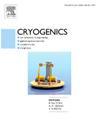An improved thermal analysis method for vapor-cooled current leads considering convective heat transfer efficiency
IF 1.8
3区 工程技术
Q3 PHYSICS, APPLIED
引用次数: 0
Abstract
As an important part of superconducting devices, the heat leakage of current leads directly affects the overall heat load of the cryogenic system. Therefore, the design of low heat leakage current leads is one of the most important issues in system design of superconducting devices. Vapor-cooled current leads (VCCL) are widely used in various superconducting devices because they have lower heat leakage compared with conduction-cooled current leads, and smaller consumption of cooling gas and higher economy compared with gas-cooled current leads. In this paper, an improved thermal analysis method for solving the heat leakage, temperature distribution and heat transfer efficiency of VCCL is proposed, which has a great advantage in terms of time-consumption and convergence while guaranteeing accuracy in comparison to conventional finite element method. Firstly, based on the heat balance equation of VCCL, the relationship of the heat transfer efficiency and convective heat transfer coefficient between VCCL and cooling gas is clarified. Subsequently, the formula to calculate the heat transfer efficiency of VCCL is derived according to heat transfer and fluid dynamics. Then, a thermal analysis method for VCCL based on iterative algorithm is put forward. Finally, the feasibility of the thermal analysis method is verified by finite element model based on COMSOL, which has been proved to be correct by experimental results in existing literature. The results indicate that for several VCCLs with typical structures, the calculation differences of heat leakage between the thermal analysis method proposed in this paper and COMSOL are all within 5 % and the calculation differences of temperature distribution are all within 10 K. However, in terms of time-consumption and convergence, the thermal analysis method proposed in this paper has a significant advantage, especially for VCCLs with complex structures.
一种考虑对流换热效率的改进汽冷引线热分析方法
电流引线作为超导器件的重要组成部分,其漏热直接影响到低温系统的整体热负荷。因此,设计低漏热电流引线是超导器件系统设计中的重要问题之一。与导冷电流引线相比,气冷电流引线具有更小的热泄漏,更小的冷却气体消耗和更高的经济性,因此被广泛应用于各种超导器件中。本文提出了一种改进的热分析方法,用于求解VCCL的热泄漏、温度分布和传热效率,与传统的有限元方法相比,该方法在保证精度的同时,在耗时和收敛方面具有很大的优势。首先,基于VCCL的热平衡方程,明确了VCCL与冷却气体之间的换热效率和对流换热系数的关系。然后,根据传热学和流体力学的理论推导了VCCL换热效率的计算公式。然后,提出了一种基于迭代算法的VCCL热分析方法。最后,通过基于COMSOL的有限元模型验证了热分析方法的可行性,并通过现有文献的实验结果证明了该方法的正确性。结果表明,对于几种典型结构的vccl,本文所提出的热分析方法与COMSOL的热泄漏计算差值均在5%以内,温度分布计算差值均在10k以内。然而,在耗时和收敛性方面,本文提出的热分析方法具有明显的优势,特别是对于结构复杂的vccl。
本文章由计算机程序翻译,如有差异,请以英文原文为准。
求助全文
约1分钟内获得全文
求助全文
来源期刊

Cryogenics
物理-热力学
CiteScore
3.80
自引率
9.50%
发文量
0
审稿时长
2.1 months
期刊介绍:
Cryogenics is the world''s leading journal focusing on all aspects of cryoengineering and cryogenics. Papers published in Cryogenics cover a wide variety of subjects in low temperature engineering and research. Among the areas covered are:
- Applications of superconductivity: magnets, electronics, devices
- Superconductors and their properties
- Properties of materials: metals, alloys, composites, polymers, insulations
- New applications of cryogenic technology to processes, devices, machinery
- Refrigeration and liquefaction technology
- Thermodynamics
- Fluid properties and fluid mechanics
- Heat transfer
- Thermometry and measurement science
- Cryogenics in medicine
- Cryoelectronics
 求助内容:
求助内容: 应助结果提醒方式:
应助结果提醒方式:


